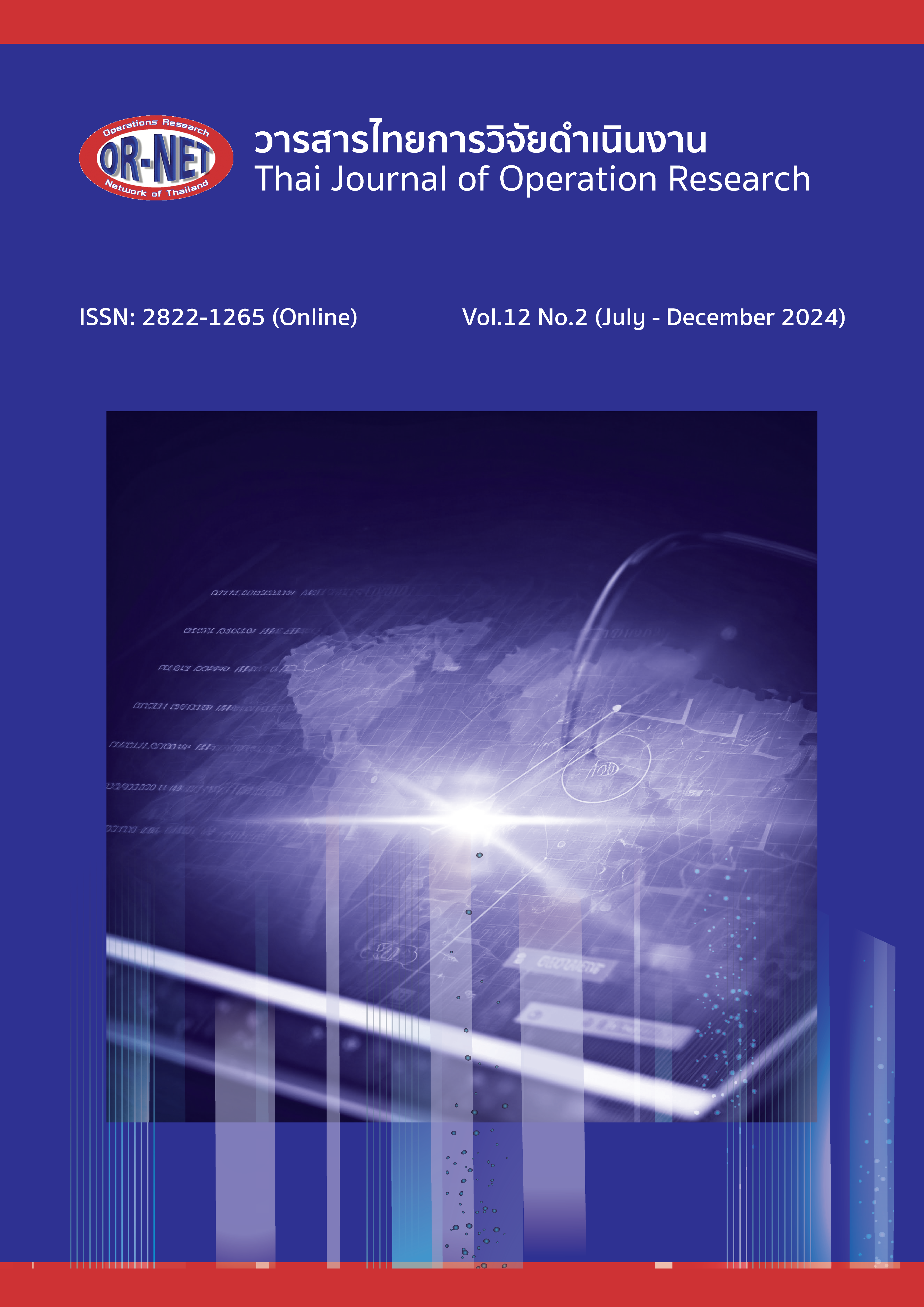Planning a Tourist Route with the Objective of Maximizing Tourist Satisfaction Within Budget and Time Constraints Using a Mixed Integer Linear Programming Model
Keywords:
mixed integer linear programming, route planning, travelAbstract
Planning a tourist route to create an optimal tourist itinerary is crucial because it can save travel time, travel expenses, as well as provide satisfaction and memorable experiences from the journey. This paper presents a mixed integer linear programming model for planning a tourist route that is based on the traveling salesman problem. The proposed model has two objectives. The first is the main objective which is to maximize the satisfaction of tourists with the tourist attractions on the tourist route. The second is the secondary objective which is to minimize the overall travel distance. The constraints considered in this study include ensuring that the expenses and time spent visiting all tourist attractions within the tourist route do not exceed the limits set by the tourists. Furthermore, the tourists must start at the starting point (meeting point or accommodation), go through all tourist attractions along the tourist route, and then come back to the starting point. In this paper, some tourist attractions may not be selected to be on the tourist route due to budget and time constraints. The proposed model was tested with three test problems (Problems 1 – 3) using data on six interesting tourist attractions in Bangkok, 11 in Nakhon Pathom, and 16 in Ayutthaya, respectively. Each problem was assigned a maximum visit time to all tourist attractions on the route, not exceeding 8 hours, and a budget for the entire tour, not exceeding 1400, 1800, and 500 Baht for Problems 1 – 3, respectively. The results showed that the proposed model could find an optimal tourist route for all test problems, where the number of selected tourist attractions on the optimal tourist route in Problems 1 – 3 are 6, 9, and 13, respectively. The solution from the proposed model can be used to create a travel timetable specifying arrival and departure times for each destination. Moreover, it can be used as an option to find an optimal tourist route for travelers in a real-life situation.
References
ธัญญารัตน์ บุญเชิด, ณญาดา การถาง, ชมพูนุช บัวรอด และเอื้ออารี บุญเพิ่ม, “ตัวแบบกำหนดการเป้าหมายเชิงจำนวนเต็มสำหรับการวางแผนเส้นทางท่องเที่ยวภายใต้ปัจจัยของนักท่องเที่ยว,” วารสารไทยการวิจัยดำเนินงาน., ปีที่ 10, ฉบับที่ 1, น. 153-165, 2565.
P. Vansteenwegen, W. Souffriau, G. V. Berghe, and D. V. Oudheusden, “Iterated local search for the team orienteering problem with time windows,” Computers & Operations Research., vol. 36, no. 12, pp. 3281-3290, 2009.
P. Vansteenwegen, W. Souffriau, and D. V. Oudheusden, “The orienteering problem: A survey,” European Journal of Operational Research., vol. 209, no. 1, pp. 1-10, 2011.
C. Zhu, J. Hu, F. Wang, Y. Xu, and R. Cao, “On the tour planning problem,” Annals of Operations Research., vol. 192, no. 1, pp. 67-86, 2012.
X. Wu, H. Guan, Y. Han and J. Ma, “A tour route planning model for tourism experience utility maximization,” Advances in Mechanical Engineering., vol. 9, no. 10, 2017.
Z. Hashim and W. R. Ismail, “Self-drive tourism route in Terengganu: an application of goal programming model,” Sains Humanika., vol. 9, no. 1-5, pp. 51-57, 2017.
A. Afriani, H. Saleh and M. D. H. Gamal, “An application of goal programming: The best route to discover a wonderful west sumatera,” International Journal of Management and Fuzzy Systems., vol 5, no. 1, pp. 9-13, 2019.
G. Brandinu and N. Trautmann, “A mixed-integer linear programming approach to the optimization of event-bus schedules: a scheduling application in the tourism sector,” Journal of scheduling., vol. 17, pp. 621-629, 2014.
W. Sirirak and R. Pitakaso, “Marketplace location decision making and tourism route planning,” Administrative sciences., vol. 8, no. 4, pp. 1-25. 2018.
T. Bektaş and S. Elmastaş, “Solving school bus routing problems through integer programming,” Journal of the Operational Research Society., vol. 58, no. 12, pp. 1599-1604, 2007.
A. Cheng, and A. Dumrongsiri, “A Memetic Algorithm for Tour Trip Design Problem,” In 15th International Joint Symposium on Artificial Intelligence and Natural Language Processing (iSAI-NLP), Bangkok, 2020.
A. Baizal, K. M. Lhaksmana, A. A. Rohmawati, M. Kirom and Z. Mubarok, “Travel route scheduling based on user’s preferences using simulated annealing,” International Journal of Electrical and Computer Engineering., vol. 9, no. 2, pp. 1275-1287. 2019.
V. F. Yu, N. Y. Salsabila, S. W. Lin, A. Gunawan, “Simulated annealing with reinforcement learning for the set team orienteering problem with time windows,” Expert Systems with Applications., vol. 238, 2024.
X. Chou, L. M. Gambardella and R. Montemanni, “A tabu search algorithm for the probabilistic orienteering problem,” Computers & Operations Research., vol. 126, 2021.
W. Zheng, H. Ji, C. Lin, W. Wang and B. Yu, “Using a heuristic approach to design personalized urban tourism itineraries with hotel selection,” Tourism Management., vol. 76, 2020.
Downloads
Published
How to Cite
Issue
Section
License

This work is licensed under a Creative Commons Attribution-NonCommercial-NoDerivatives 4.0 International License.




